The Lost Generation: Women Ceramicists and the Cuban Avant-Garde | La generación perdida: mujeres ceramistas y la vanguardia cubana
In the Daley Family and Monan Galleries | En las Galerías Familia Daley y Monan
January 29–June 2, 2024 | 29 de enero–2 de junio 2024
Click thumbnails to view selected objects in exhibition | Haga clic en las miniaturas para ver algunas obras de la exposición
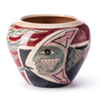

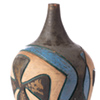
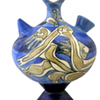
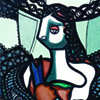
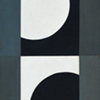



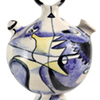
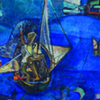

E-book | Libro electrónico Catalogue | Catálogo Press Release | Noticia de prensa Didactics | Didáctica Virtual Walkthrough | Recorrido virtual
English text
The Lost Generation: Women Ceramicists and the Cuban Avant-Garde examines the participants and artistic output from 1949 to 1959 of the Taller de Santiago de las Vegas, a ceramic workshop on the outskirts of Havana. A decade of artistic experimentation primarily by little-known women ceramicists had deep reverberations both for the acceptance of ceramics as a fine art form in Cuba and for the symbiotic relationship that flourished between the ceramicists and the painters, largely men, who visited the Taller to learn the craft. The painters in turn applied new techniques and methodologies to their two-dimensional production, which is now regarded as synonymous with the Cuban avant-garde (vanguardia).
At the helm of the Taller was a physician, Juan Miguel Rodríguez de la Cruz, who formed and fired the ceramics and hired mainly women, many of whom were trained at the prestigious Academia San Alejandro and other fine arts schools, to decorate the wares. These ceramicists created their own styles, establishing an artistic movement that garnered national and international recognition. Rebeca Robés Massés, Marta Arjona, María Elena Jubrías, Mirta García Buch, Amelia Peláez, and numerous others were key ceramicists at the Taller. They and Rodríguez de la Cruz welcomed the participation of renowned modernist painters and sculptors, including René Portocarrero, Wifredo Lam, Raúl Milián, Wifredo Arcay, Luis Martínez Pedro, Mariano Rodríguez, and Agustín Cárdenas. The trajectory of ceramics following the Cuban Revolution of 1959 is also explored in the exhibition; many of those who worked at the Taller went on to found their own independent workshops, furthering the commercialization, and acceptance, of fine art modernist ceramics on the island.
Featuring nearly 150 vases, mugs, water jugs, murals, and plates drawn from premier private and gallery collections, The Lost Generation displays for the first time many of the Taller’s finest ceramics in conversation with dozens of paintings and sculptures by Peláez, Portocarrero, Lam, Martínez Pedro, Mariano, and others.
The Lost Generation is accompanied by a bilingual catalogue, illustrating each work in the exhibition. With contributions from Roberto Cobas Amate, Alejandro Anreus, Elizabeth Thompson Goizueta, and Carol Damian, the volume explores the origins of late nineteenth- and early twentieth-century art in Cuba, the protagonists of the first two generations of the vanguardia, the importance for Cuban modernism of the women ceramicists’ involvement in the Taller de Santiago de las Vegas, and the stylistic contributions of the women artists.
Organized by the McMullen Museum, The Lost Generation has been curated by Elizabeth Thompson Goizueta and underwritten by Boston College with major support from the Patrons and the Hispanic Art Initiative of the McMullen Museum.
The exhibition will be on view at the Patricia & Phillip Frost Art Museum, Florida International University, from June 29 to September 29, 2024.
Texto en español
La generación perdida: mujeres ceramistas y la vanguardia cubana examina a los participantes y la producción artística del Taller de Santiago de las Vegas entre 1949 y 1959, un taller de cerámica en las afueras de La Habana. Fue esta una década de experimentación artística de un grupo de mujeres ceramistas poco conocidas, que alcanzó profundas resonancias por la aceptación de la cerámica como arte en Cuba y por la relación simbiótica que floreció entre ceramistas y los pintores, casi todos hombres, que visitaron el Taller para aprender nuevas destrezas. Por su parte, y como resultado de estas experiencias, los pintores aplicaron nuevas técnicas y metodologías a su producción bidimensional, esa que hoy consideramos representativa de la vanguardia cubana.
Al frente del Taller estaba un médico, Juan Miguel Rodríguez de la Cruz, que modelaba y horneaba la cerámica y contrató fundamentalmente mujeres, muchas de ellas entrenadas en la prestigiosa Academia San Alejandro y otras escuelas de arte, para que decoraran las piezas. Estas ceramistas crearon sus propios estilos, estableciendo un movimiento artístico que recibió reconocimiento nacional e internacional. Rebeca Robés Massés, Marta Arjona, María Elena Jubrías, Mirta García Buch, Amelia Peláez y muchas otras fueron ceramistas clave en el Taller. Junto a Rodríguez de la Cruz, ellas le dieron la bienvenida a renombrados pintores y escultores, como René Portocarrero, Wifredo Lam, Raúl Milián, Wifredo Arcay, Luis Martínez Pedro, Mariano Rodríguez y Agustín Cárdenas. La trayectoria de la cerámica después de la Revolución cubana de 1959 es también explorada en esta exposición; muchos de los que trabajaron en el Taller eventualmente fundaron sus propios estudios, incrementando la comercialización y aceptación de la cerámica artística en la isla.
Presentando casi 150 vasos, jarras, porrones, murales y platos provenientes de importantes galerías y colecciones privadas, La generación perdida exhibe por primera vez muchas de las mejores cerámicas del Taller en conversación con docenas de pinturas y esculturas de Peláez, Portocarrero, Lam, Martínez Pedro, Mariano y otros.
La generación perdida es acompañada por un catálogo bilingüe que contiene cada obra de la exposición. Con contribuciones de Roberto Cobas Amate, Alejandro Anreus, Elizabeth Thompson Goizueta y Carol Damian, el catálogo explora los orígenes del arte cubano de finales del siglo diecinueve y principios del veinte, los protagonistas de las dos generaciones de vanguardia, la importancia de la cerámica femenina producida en el Taller de Santiago de las Vegas para el arte moderno cubano, y las contribuciones estilísticas de las mujeres artistas.
Organizada por el McMullen Museum, La generación perdida ha sido curada por Elizabeth Thompson Goizueta y subvencionada por Boston College con crucial apoyo de los Patrocinadores y de la Iniciativa de Arte Hispano del McMullen Museum.
La exposición estará abierta al público en el Patricia & Phillip Frost Art Museum, Florida International University, del 29 de junio al 29 de septiembre de 2024.













